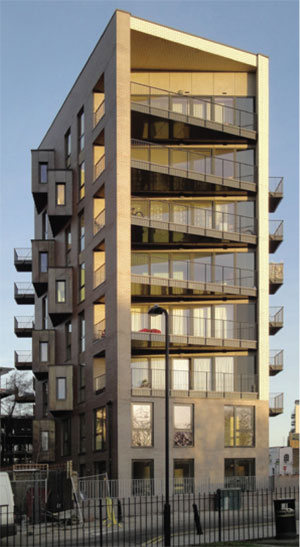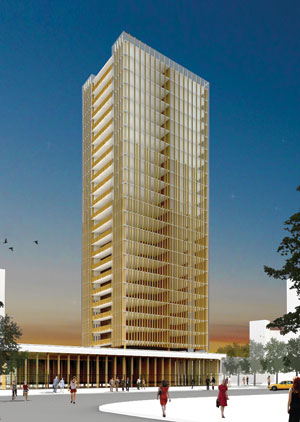Tall Wood Takes a Stand
Tall Wood Building Report
 |
When it was constructed in 2011, Bridport House was the largest timber-built apartment block in the world. Photo courtesy of Karakusevic Carson Architects |
In February 2012, Green and Karsh issued the Tall Wood report, which was funded with support from the Canadian Wood Council (CWC) on behalf of the Wood Enterprise Coalition (WEC) by Forestry Innovation Investment (FII).
Citing climate change as the principal reason for promoting the idea of using sustainably grown wood to build tall buildings, Green says, “We must find solutions for our urban environments that have a lighter climate impact than today's incumbent major structural materials. The Tall Wood report is a major step in that direction. Indeed, it introduces the first significant challenge to steel and concrete in tall buildings since their adoption more than a century ago.”
The 240-page report highlights the feasibility of using mass timber building techniques and engineered wood building products, including cross laminated timber (CLT), laminated veneer lumber (LVL), laminated strand lumber (LSL), glued laminated beams (glulam), and others to build structures up to 30 stories. The report also details the ways in which tall timber structures can offer safe, economical, and environmentally friendly alternatives to steel and concrete.3
The Inspiration Behind Tall Wood Buildings
What's driving the move to use wood in taller buildings? While cost effectiveness is usually viewed as the main reason to use wood, most building professionals involved in this movement cite the environment as their inspiration. They are driven by the need to find safe, carbon-neutral, and sustainable alternatives to steel and concrete. Tall wood structures allow designers to achieve both of these objectives: higher density at lower cost and a smaller carbon footprint for their projects.
While tall wood buildings are increasingly common in Europe and now Australia, the U.S. and Canada are still looking for sustainable building solutions, says Nabih Tahan, AIA, with Cree Buildings, Inc., a subsidiary of Cree GmbH in Austria, the developers of the LCT ONE. “Architects are realizing that the old ways of doing things will not continue to work; we are ruining the environment. Because of this, we're now seeing an industrial revolution for wood. Wood is a renewable product that can do much more than we have yet asked of it.”
Advancements in mass timber building techniques and the development of engineered wood building materials such as CLT, LSL, and LVL are also allowing building designers to take wood higher than ever. The International Building Code (IBC) already allows wood-frame construction for five stories (and more if the structure includes a mezzanine or terrace) in many types of building occupancies, including multi-family and offices. These buildings, which utilize dimension lumber and structural wood panels as well as engineered lumber components, have proven themselves to be cost-effective alternatives to steel and concrete.4 Mass timber construction allows wood to move to the next level.
What Products Make Tall Wood Possible?
Technical development and growing availability of the following structural composite panel and lumber products enable the tall wood opportunity:
 |
In their Tall Wood report, authors Green and Karsh present a strong case for wood buildings up to 30 stories tall. Rendering courtesy of MGA |
Cross laminated timber (CLT) is an engineered wood panel typically consisting of three, five, or seven layers of dimension lumber oriented at right angles to one another and then glued to form structural panels with exceptional strength, dimensional stability, and rigidity. CLT is manufactured to customized dimensions; panel sizes vary by manufacturer. It is currently available in North America with dimensions up to 19-1/2 inches thick, 18 feet wide, and 98 feet long. While length is usually limited by transportation restrictions, longer panels can be manufactured. CLT panels are typically installed like plywood in terms of grain orientation. Wall panels are oriented with the grain of the outside layers parallel to the vertical loads of the application. Floor and roof applications have the grain of their exterior layers oriented parallel to the span direction.
Laminated veneer lumber (LVL) is produced by bonding thin wood veneers together using waterproof adhesives under heat and pressure and then sawn to desired dimensions. The wood grain of the veneers is oriented parallel to the length of the member. Since it is manufactured with kiln-dried wood veneers and because each veneer layer is oriented in the same direction, LVL has predictable structural performance and dimensional stability, being virtually free from warping and splitting. LVL can be manufactured in a broad range of widths, depths, and lengths.
Laminated strand lumber (LSL) is also an engineered structural composite lumber product manufactured by aligning thin chips or strands of wood up to 6 inches in length and then gluing them under pressure. Like LVL, the wood grain of the strands is oriented parallel to the length of the member, and then the wood member is machined to consistent finished sizes. Common LSL sizes range up to 8 feet wide and 64 feet long. It is strong when either face- or edge-loaded, but typically has lower strength and stiffness properties than LVL.5
Glued laminated timber (glulam) is composed of individual wood laminations (dimension lumber), specifically selected and positioned based on their performance characteristics, and then bonded together with durable, moisture-resistant adhesives. The grain of all laminations runs parallel with the length of the member. Glulam can be used in horizontal applications as a beam, or vertically as a column. Glulam is available in depths from 6 to 72 inches or greater and in lengths up to 100 feet and longer. Glulam has excellent strength and stiffness properties; pound for pound, it is stronger than steel,6 and is available in a range of appearance grades for structural or architectural applications.









